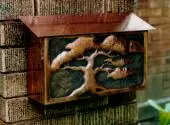FMG Designs: An Unexpected Career Greeted With a Smile

If you’ve ever met Frank Glapa you know that smile I’m talking about — warm, inviting and genuinely excited to talk to you about whatever it is that happens to be on his mind. I’ve got to be honest, both he and his wife, Anastasia, are two people I look forward to seeing every year at the Grove Park Inn Arts & Crafts Conference (one Glapa has been exhibiting in since 1998, I might add). They’re people you just look forward to seeing and speaking to. And that just so happened to be me a couple of weeks ago when I had an interview, turned lively conversation, about photography, Frank’s business and everything in between.
Just after the end of World War II, Frank was born in Germany and emigrated with his parents a few years later to Buffalo, NY. His initial interest in the Arts & Crafts movement came about in his earlier years in Buffalo while visiting the Albright Knox Gallery and the nearby Frederick Law Olmsted designed Delaware Park neighborhood. He recalls his fascination with the layout of the streets and how there was this seamless relationship shared between the buildings and streets. This National Trust historic area with its Frank Lloyd Wright designed Burton and Heath Houses, and later The Larkin Company Building, which once stood near his old neighborhood, made a permanent impression on him as a young student.
After attending the Columbus College of Art and Design on a full college scholarship, Frank made an eventual transfer to The School of the Art Institute of Chicago because of his interest in sculpture. He also pursued photography (which, having a B.A. in Photography myself, we had to bond over briefly) as well as printmaking and was a T.A. in the etching department while at The Art Institute.
After a brief time serving in the military and a permanent relocation to Chicago, Frank spent 20 years in the advertising industry utilizing his knowledge of photography and honing his design skills. He and Anastasia eventually began looking for a well-built house with good design, and when a super size 1924 Chicago brick bungalow was available (now registered with the Historic Chicago Bungalow Association) it became home. Living in an Arts & Crafts Prairie house became part of Frank’s everyday life, so copper metalworking was the next natural progression. And thus began his career in metalwork in 1996.
As it happens, a new neighbor needed a spacious Arts & Crafts style mailbox to accommodate his magazines. So Frank went to work designing and producing a copper mailbox gathering inspiration from the works of Charles Rennie Mackintosh and his famous Glasgow Rose as well as the Roycrofters Guild of East Aurora, New York. Following the commission, an ad in American Bungalow Magazine for the “Bungalow Mailbox” brought in more orders and Frank was on his way.
Frank was clearly up for the challenge when faced with a new career. The invitation to participate at the 1st Annual Symposium at Gustav Stickley’s Craftsman Farms, in Parsippany, NJ in 1996 started Frank on the road to becoming a Roycroft Renaissance Artisan in 2000 and 2001, and a Master Artisan in 2003.
He has since added many new designs from that initial mailbox, which are truly inspired by nature and many other themes present throughout the Arts & Crafts movement. If you look closely, you’ll find Frank’s mailbox and lantern designs on Bungalows, Craftsman, Mission, Prairie and Arts & Crafts style landmark homes in the U.S., Canada and Japan as well as on a handful of Frank Lloyd Wright designed homes.Lately he’s also been teaching a handful of metalwork classes stating, “It’s easy if we make it accessible.” As for the advice he doles out to students and fellow up and coming artists, “Look at the things I make. They’re not perfect but I just go for it.” …and always with a smile.
For more information on Frank and to see his work please visit his website at www.fmgdesigns.com

